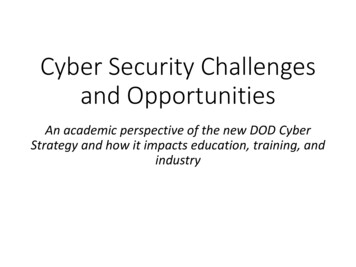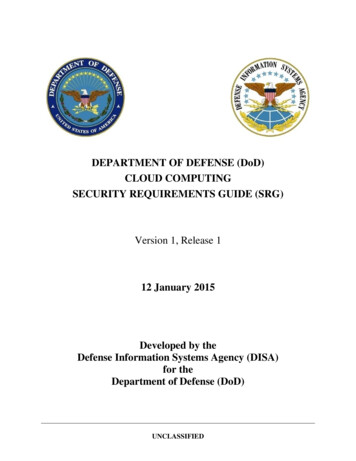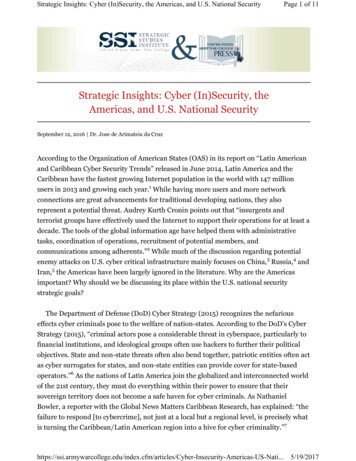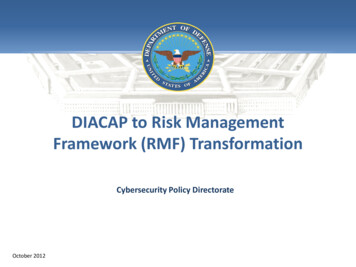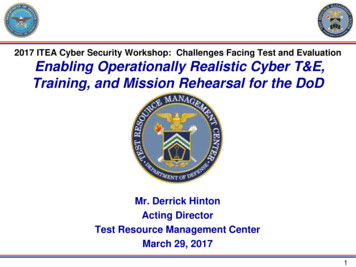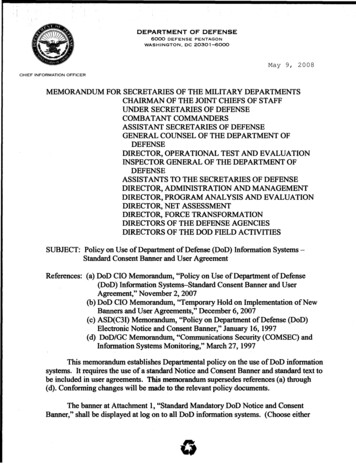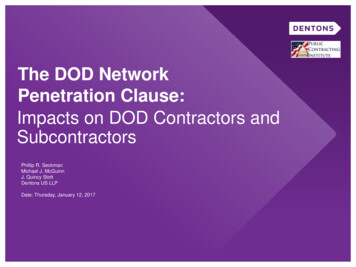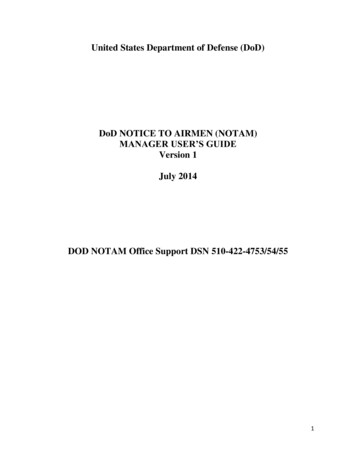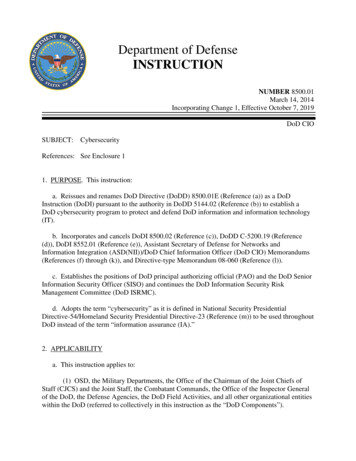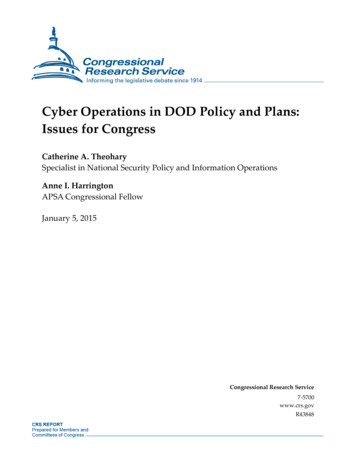
Transcription
Cyber Operations in DOD Policy and Plans:Issues for CongressCatherine A. TheoharySpecialist in National Security Policy and Information OperationsAnne I. HarringtonAPSA Congressional FellowJanuary 5, 2015Congressional Research Service7-5700www.crs.govR43848
Cyber Operations in DOD Policy and Plans: Issues for CongressSummaryCyberspace is defined by the Department of Defense as a global domain consisting of theinterdependent networks of information technology infrastructures and resident data, includingthe Internet, telecommunications networks, computer systems, and embedded processors andcontrollers. Attacks in cyberspace have seemingly been on the rise in recent years with a varietyof participating actors and methods. As the United States has grown more reliant on informationtechnology and networked critical infrastructure components, many questions arise about whetherthe nation is properly organized to defend its digital strategic assets. Cyberspace integrates theoperation of critical infrastructures, as well as commerce, government, and national security.Because cyberspace transcends geographic boundaries, much of it is outside the reach of U.S.control and influence.The Department of Homeland Security is the lead federal agency responsible for securing thenation’s non-security related digital assets. The Department of Defense also plays a role indefense of cyberspace. The National Military Strategy for Cyberspace Operations instructs DODto support the DHS, as the lead federal agency, in national incident response and support to otherdepartments and agencies in critical infrastructure and key resources protection. DOD isresponsible for defensive operations on its own information networks as well as the sectorspecific agency for the defense of the Defense Industrial Base. Multiple strategy documents anddirectives guide the conduct of military operations in cyberspace, sometimes referred to ascyberwarfare, as well as the delineation of roles and responsibilities for national cybersecurity.Nonetheless, the overarching defense strategy for securing cyberspace is vague and evolving.This report presents an overview of the threat landscape in cyberspace, including the types ofoffensive weapons available, the targets they are designed to attack, and the types of actorscarrying out the attacks. It presents a picture of what kinds of offensive and defensive tools existand a brief overview of recent attacks. The report then describes the current status of U.S.capabilities, and the national and international authorities under which the U.S. Department ofDefense carries out cyber operations. Of particular interest for policy makers are questions raisedby the tension between legal authorities codified at 10 U.S.C., which authorizes U.S. CyberCommand to initiate computer network attacks, and those stated at 50 U.S.C., which enables theNational Security Agency to manipulate and extrapolate intelligence data—a tension thatPresidential Policy Directive 20 on U.S. Cyber Operations Policy manages by clarifying thePentagon’s rules of engagement for cyberspace. With the task of defending the nation fromcyberattack, the lines of command, jurisdiction, and authorities may be blurred as they apply tooffensive and defensive cyberspace operations. A closely related issue is whether U.S. CyberCommand should remain a sub-unified command under U.S. Strategic Command that sharesassets and its commander with the NSA. Additionally, the unique nature of cyberspace raises newjurisdictional issues as U.S. Cyber Command organizes, trains, and equips its forces to protect thenetworks that undergird critical infrastructure. International law governing cyberspace operationsis evolving, and may have gaps for determining the rules of cyberwarfare, what constitutes an“armed attack” or “use of force” in cyberspace, and what treaty obligations may be invoked.Congressional Research Service
Cyber Operations in DOD Policy and Plans: Issues for CongressContentsIntroduction. 1Background . 2Cyberspace: The Operating Environment . 2Cyber Weapons . 3Malware. 3Botnets. 3Distributed Denial of Service Attacks . 4Automated Defense Systems . 5Targets . 5Government and Military Networks. 5Critical Infrastructure and Industrial Control Systems . 6Actors and Attribution . 6Nation States . 6Politically Motivated Hacktivists . 7Terrorists and Organized Crime . 7Advanced Persistent Threats . 7Attribution Issues . 7Threat Environment . 8Cyberattack Case Studies . 8The DOD and U.S. Cyber Command . 13Cyber Command Mission and Force Structure . 13USCYBERCOM and Information Sharing . 15Authorities . 15Legislative Authorities. 16Executive Authorities . 17International Authorities . 21The U.S. Position on International Authorities . 21International Consensus-Building Activities . 22Existing International Instruments That Bear on Cyberwarfare. 23Issues for Congress . 27Authorities: Is Current Law Enough? . 27How Do DOD and Cyber Command Responsibilities for Cybersecurity Fit Within theInteragency and Private Sector? . 28Should U.S. Cyber Command Be Its Own Unified Combatant Command? . 28Is a Separate Cyber Force Necessary? . 28What Are the Authorizing and Oversight Committees and Jurisdictional Implications? . 28Current Legislation . 28AppendixesAppendix. Timeline of International Attacks . 30Congressional Research Service
Cyber Operations in DOD Policy and Plans: Issues for CongressContactsAuthor Contact Information. 33Congressional Research Service
Cyber Operations in DOD Policy and Plans: Issues for CongressIntroduction1Cyberspace has taken on increased strategic importance as states have begun to think of it as yetanother domain—similar to land, sea, and air—that must be secured to protect their nationalinterests. Cyberspace is another dimension, with the potential for both cooperation and conflict.The Obama Administration’s 2010 National Security Strategy identifies cybersecurity threats “asone of the most serious national security, public safety, and economic challenges.”Cyberattacks are now a common element of international conflict, both on their own and inconjunction with broader military operations. Targets have included government networks, mediaoutlets, banking services, and critical infrastructure. The effects and implications of such attacksmay be small or large; cyberattacks have defaced websites, temporarily shut down networks andcut off access to essential information and services, and damaged industrial infrastructure.Despite being relatively common, cyberattacks are difficult to identify at their source and thwart,in particular because politically motivated attacks are often crowd-sourced,2 and online criminalorganizations are easy to join. Suspicions of state-sponsored cyberattacks are often strong butdifficult to prove. The relative anonymity under which actors operate in cyberspace affords adegree of plausible deniability.This report focuses specifically on cyberattacks as an element of warfare, separate and distinctfrom diplomatic or industrial espionage, financially motivated cybercrime, or state-basedintimidation of domestic political activists.3 However, drawing clean lines between cyberwar,cyberterrorism, cyberespionage, and cybercrime is difficult. State and non-state actors carry outcyberattacks every day. When and under what conditions cyberattacks rise to the level ofcyberwar is an open question. Some experts contend that all warfare, including cyberwarfare, bydefinition includes the destruction of physical objects. According to this point of view, to be anact of cyberwarfare, the attack must originate in cyberspace and result in the destruction ofcritical infrastructure, military command-and-control capabilities, and/or the injury or death ofindividuals.4 On the other hand, some analysts have a more inclusive view of cyberwarfare. Theseexperts would include, in addition to cyberattacks with kinetic effects, the exfiltration orcorruption of data, the disruption of services, and/or manipulation of victims through distraction.As our military becomes increasingly information dependent, potential vulnerabilities in networkcentric operations are crystalized. A cyberattack on a military asset may be considered an act ofwar to which the military will respond under the Law of Armed Conflict. However, there mayalso be attacks on civilian systems which would warrant a military response.1Information contained in this report is derived from unclassified open source material and discussions with seniorgovernment officials and industry technology and security experts.2Crowd-sourcing refers to the use of online communities to obtain ideas, information, and services.3Industrial espionage events are widely covered and notorious: attacks on Target, Home Depot, and Sony have caughtnational attention and have serious economic implications. Such events, however challenging, are not consideredwarfare for purposes of this report.4Bruce Schneier, Schneier on Security (Indianapolis: Wiley, 2008); Michael Schmitt et al., Tallinn Manual on theInternationl Law Applicable to Cyber Warfare, prepared by the International Group of Experts at the invitation of theNATO Cooperative Cyber Defence Centre of Excellence, Cambridge: Cambridge University Press, 2013.Congressional Research Service1
Cyber Operations in DOD Policy and Plans: Issues for CongressBackgroundCyberspace: The Operating EnvironmentThe Internet represents a portion of the global domain of cyberspace; however, there are networksand systems that are not connected to the Internet. Included among these are national strategicassets whose compromise could have serious consequences. In its 2010 Quadrennial DefenseReview, the Department of Defense (DOD) identified cyberspace as a global commons ordomain, along with air, sea and space. Previous views of cyberspace had focused mainly on theenabling or force multiplier aspects of information technology and networked workfare.Cyberspace is currently defined by the DOD as a global domain within the informationenvironment consisting of the interdependent networks of information technology infrastructuresand resident data, including the Internet, telecommunications networks, computer systems, andembedded processors and controllers.5 It is also described in terms of three layers: (1) a physicalnetwork, (2) a logical network, and a (3) cyber-persona:6 The physical network is composed of the geographic and physical networkcomponents. The logical network consists of related elements abstracted from the physicalnetwork, (e.g., a website that is hosted on servers in multiple locations butaccessed through a single URL). The cyber-persona layer uses the rules of the logical network layer to develop adigital representation of an individual or entity identity.Because one individual or entity can have multiple cyber personae, and vice versa, attributingresponsibility and targeting attacks in cyberspace is challenging. Another challenge lies in insiderthreats, when an authorized user or users exploits legitimate access to a network for nefariouspurposes.From a military perspective, the operational environment is a composite of the conditions,circumstances, and influences that affect the employment of capabilities and bear on the decisionsof the commander.7 The information environment is the aggregate of individuals, organizations,and systems that collect, process, disseminate, or act on information, further broken down into thephysical, informational, and cognitive dimensions.Cyberspace operations employ capabilities whose primary purpose is to achieve objectives in orthrough cyberspace. The following section gives examples of some of the tools through whichthese objectives may be achieved.5Department of Defense Joint Publication 3-12, Cyberspace Operations, February 5, 2013.Ibid.7Ibid.6Congressional Research Service2
Cyber Operations in DOD Policy and Plans: Issues for CongressCyber WeaponsThere are several tools through which effects in cyberspace are achieved. Effects can range inseverity from disrupting or slowing down access to online goods and services, to degrading anddestroying entire network operations. The actors who employ these tools can range fromindividual hacker groups to nation states and their proxies. The following section describes themost common attack tools, or cyber weapons, that these actors employ.MalwareMalware is a general term for malicious software. Bots, viruses, and worms are varieties ofmalware. Bots, as described below, are used to establish communication channels among personalcomputers, linking them together into botnets that can be controlled remotely. Botnets are oneway that other forms of malware, such as viruses and worms, spread. As the names imply, virusesspread by infecting a host. They attach themselves to a program or document. In contrast, wormsare stand alone, self-replicating programs.8The first known malware aimed at PCs, a virus, was coded in 1986 by two brothers in Pakistan.They named the virus Brain after their computer shop in Lahore and included their names,addresses, and phone numbers in the code. Calling Brain malware is slightly misleading becausethe brothers had no ill intentions. They were simply curious to find out how far their creationcould travel. Within a year it had traveled around the globe.9Malware that targets the internal networks of particular companies are often spread by infecting“watering-holes,” a term for public websites frequented by employees. Another common methodis “spearphishing”—sending emails to targeted individuals that contain malicious links. Theemail appears to be innocuous and sent from a trusted source, but clicking on the link opens avirtual door to outsiders.10 So-called “air-gapped” networks, computer systems that are notconnected to the Internet, are not vulnerable to these types of attacks; however, such networks canbe infected by viruses and worms when an external device, such as a thumb drive, is inserted intoa networked computer.BotnetsRobotic networks, commonly known as botnets, are chains of home and business PCs linkedtogether by a script or program. That program (the bot) enables a single operator to command allof the linked machines. Botnets are not necessarily malicious. The computer code botnets use alsoenables desirable communication across the Internet, such as the chat rooms that were popular inthe 1990s. However, programmers have figured out how to exploit vulnerabilities in widely usedMicrosoft Windows operating platforms to degrade, destroy, and manipulate computer8CRS Report R41524, The Stuxnet Computer Worm: Harbinger of an Emerging Warfare Capability, by Paul K. Kerr,John W. Rollins, and Catherine A. Theohary.9Joshua Davis, “John McAfee Fled to Belize, But He Couldn’t Escape Himself,” Wired, December 24, last-stand/all.10Chris Strohm, “Hedge-Fund Hack Part of Wall Street Siege Seen by Cyber-Experts,” BloombergGovernment, June23, 2014.Congressional Research Service3
Cyber Operations in DOD Policy and Plans: Issues for Congressnetworks—often without the knowledge of the machine’s owner or local operator.11 Because theyare automated programs, when released, bots lurk on the Internet and take over computers,turning them into a network of “zombies” that can be operated remotely. The majority of emailspam is generated by botnets without the host computer’s knowledge.12 In fact, owners are oftennot aware that their computers are part of a botnet, the only indication of which is sluggishresponse time.13Early botnet operators were often skilled coders. In contrast, today an underground industry ofskilled botnet providers exists, but operators no longer have to be fluent coders. Starting in 2004,bots got considerably easier to use as the result of new applications that allowed hackers to buildbots by pointing and clicking, resulting in a bloom of spam in email inboxes across the globe.14 Inaddition to unwanted advertising, botnets can generate denial-of-service (DoS) attacks and spreadmalware.Distributed Denial of Service AttacksDistributed Denial of Service (DDoS) attacks flood their target with requests, consuming thetarget’s bandwidth and/or overloading the capacity of the host server, resulting in service outages.These attacks are “distributed” because effective attacks employ botnets, distributing the sourceof requests across an entire network of zombie computers. DDoS attacks are unique for threereasons: (1) they exploit vulnerabilities in their target’s software or operating system that cannotbe easily repaired or “patched;” (2) each individual packet is a legitimate request—only the rateand total volume of packets gives an attack its destructive impact; and (3) the severity of theattack is measured in terms of its duration. Unlike malware, which alters or infects its target,DDoS attacks consist of the same types of packets, a unit of data, that a typical user would sendwhen making a legitimate request. The only difference is in the number and frequency with whichthe attacker generates requests. The goal of a DDoS attack is to render targeted networksunavailable or non-responsive, thereby preventing users from accessing information for theduration of the attack.15The pathway of a DDoS attack is known as a vector. Today it is common for an attack to havemultiple vectors. A DDoS attack carried out by botnets along multiple vectors can interruptservices for days, weeks, or even months. More sophisticated attacks take advantage of vectorsthat amplify their strength through a process that generates exponential reverberations. The abilityto amplify an attack, for instance by tricking a server into responding to a target with an evenlarger packet than what was originally sent, increases an already substantial asymmetricadvantage. Botnet applications not only make DDoS attacks relatively easy to mount, but the11Zheng Bu, Pedro Bueno, Rahul Kashyap, et al., The New Era of Botnets, McAfee: An Intel Company, white paper,Santa Clara, CA, 2010, pp. 3-4, -new-era-of-botnets.pdf.12John Markoff, “A Robot Network Seeks to Enlist Your Computer,” New York Times, October 20, 2008.13Richard A. Clark and Robert K. Knake, Cyber War: The Next Threat to National Security and What to Do about It(New York: HarperCollins, 2010), p. 13.14Zheng Bu, Pedro Bueno, Rahul Kashyap, et al., The New Era of Botnets, McAfee: An Intel Company, White Paper,Santa Clara, CA, 2010, pp. 3-4, -new-era-of-botnets.pdf.15Ziv Gadot, Eyal Benishti, Lior Rozen, et al., Radware Global Application & Network Security Report 2012,Radware, White Paper, Mahwah, NJ, 2013, p. 1, 6e-4cd7-bf8c236b1e7e4c67.pdf.Congressional Research Service4
Cyber Operations in DOD Policy and Plans: Issues for Congressredundant and decentralized nature of the Internet makes attribution difficult.16 In theory, a DDoSattack could temporarily take down the entire web by simultaneously targeting the 13 root serverson which all Internet traffic depends.17 In practice, this has not yet happened.Automated Defense SystemsRetaliatory hacking, a response to network breaches that has been used in the private sector, hasgained traction within DOD as a means to stage an “active defense.” These potentially offensiveoperations may occur when a systems administrator sees an intrusion and in turn breaches theassumed point of origin, either to retrieve or destroy information. However, such activities arecomplicated for two reasons: uncertainty in attack attribution and active defense may violateterms enacted in the Computer Fraud and Abuse Act of 1986.18 This law criminalizesunauthorized breaches and other computer-related activity, including the distribution of malwareand use of botnets. Although the military would be involved in a counterattack only during anational security crisis, the government may tacitly encourage companies to engage in retaliatoryhacking as the first line of defense for the nation’s critical infrastructure. For example, theDefense Advanced Research Projects Agency (DARPA) has launched a Cyber Grand Challengeprogram to hasten the development of automated security systems capable of responding to andneutralizing cyberattacks as fast as they are launched. Automated defense systems may also beconfigured to launch a counterattack in the direction of a network breach.TargetsAttacks on information technology destroy, degrade, and/or exfiltrate data from a host computer.The intended effect of a cyberattack can be related to the attack target. Within the context ofcyberwarfare, two areas are attractive targets for a potential adversary: government and militarynetworks, and critical infrastructure and industrial control systems.Government and Military NetworksNation states and other entities target government and military networks to exfiltrate data, therebygaining an intelligence advantage, or to potentially plant a malicious code that could be activatedin a time of crisis to disrupt, degrade, or deny operations. In 2008, The Pentagon itself was atarget of a massive breach, when an infected thumb drive was inserted into a computer connectedto DOD classified networks. The discovery of the malware, named Agent.btz, led to a massivecleanup operation code-named Buckshot Yankee.19 While the incident appeared to be related toespionage and theft of sensitive information, it is possible that malware could also contain ahidden, more nefarious function, such as the capability to disable communications or spreaddisinformation.16Ziv Gadot, Eyal Benishti, Lior Rozen, et al., Radware Global Application & Network Security Report 2012,Radware, white paper, Mahwah, NJ, 2013, p. 18.17http://www.root-servers.org/.1818 U.S.C. §1030.19Ellen Nakashima, “Cyber-intruder sparks response, debate” Washington Post, December 8, 2011/12/06/gIQAxLuFgO story.html.Congressional Research Service5
Cyber Operations in DOD Policy and Plans: Issues for CongressCritical Infrastructure and Industrial Control SystemsCivilian critical infrastructure comprises networks and services that are considered vital to anation’s operations and are owned and operated by the private sector.20 Examples of these sectorsinclude energy, transportation, financial services, food supplies, and communications. Thesesectors may be particularly vulnerable to cyberattack because they rely on open-source softwareor hardware, third-party utilities, and interconnected networks.Large-scale industrial control systems (ICS), such as the supervisory control and data acquisition(SCADA) systems that provide real-time information to remote operators, present a uniquevulnerability. Disabling an electric power plant by attacking its SCADA system, for instance, willhave many follow-on effects. These systems, as they control the operations of a particularplatform, are referred to by the Defense Department as “operations technology.”From highly specialized equipment, such as uranium enrichment plants, to mundane heating andair conditioning systems and office photocopiers, the capability to remotely control industrialhardware for maintenance and operations purposes also makes these machines vulnerable tocyberattacks. Attacks against operations technology (OT) are different than informationtechnology (IT) attacks because OT attacks can produce kinetic effects. Although OT controlsprimarily mundane infrastructure, these built environments are increasingly networkedenvironments, which adds a complicated layer to training and maintenance.Actors and AttributionWith low barriers to entry, multiple actors may take part in use of the Internet and networkedtechnology as a means to achieve strategic effects. These actors may represent nation states,politically motivated hacker groups or “hactivists,” or terrorist and other criminal organizations.Directly attributing a cyberattack to any one of these groups can be challenging, particularly asthey may sometimes operate in concert with each other, though for differing motivations.Nation StatesCyberwarriors are agents or quasi-agents of nation states who develop capabilities and undertakecyberattacks to support a country’s strategic objectives.21 These entities may or may not be actingon behalf of the government with respect to target selection, attack timing, or type(s) ofcyberattack. Moreover, cyberwarriors are often blamed by the host country when the nation thathas been attacked levies accusations against that country. Typically, when a foreign government ispresented with evidence that a cyberattack is emanating from its country, the nation that has beenattacked is told that the perpetrators acted of their own volition, not at the behest of thegovernment.20Critical Infrastructure is defined in 42 U.S.C. 5195c(e) as: “systems and assets, whether physical or virtual, so vital tothe United States that the incapacity or destruction of such systems and assets would have a debilitating impact onsecurity, national economic security, national public health or safety, or any combination of those matters.”21For additional information, see CRS Report RL31787, Information Operations, Cyberwarfare, and Cybersecurity:Capabilities and Related Policy Issues, by Catherine A. Theohary.Congressional Research Service6
Cyber Operations in DOD Policy and Plans: Issues for CongressPolitically Motivated HacktivistsCyberhactivists are individuals who perform cyberattacks for pleasure, or for philosophical orother nonmonetary reasons. Examples include someone who attacks a technology system as apersonal challenge (who might be termed a “classic” hacker), and a “hacktivist,” such as amember of the cybergroup Anonymous, who undertakes an attack for political reasons. Theactivities of these groups can range from simple nuisance-related DoS attacks to disruptinggovernment and private corporation business processes.Terrorists and Organized CrimeCyberterrorists are state-sponsored or non-state actors who engage in cyberattacks as a form ofwarfare. Transnational terrorist organizations, insurgents, and jihadists have used the Internet as atool for planning attacks, recruiting and radicalizing members, distributing propa
4 Bruce Schneier, Schneier on Security (Indianapolis: Wiley, 2008); Michael Schmitt et al., Tallinn Manual on the Internationl Law Applicable to Cyber Warfare, prepared by the International Group of Experts at the invitation of the NATO Cooperative Cyber Defence Centre of Excellence, Cambridge: Cambridge University Press, 2013.
